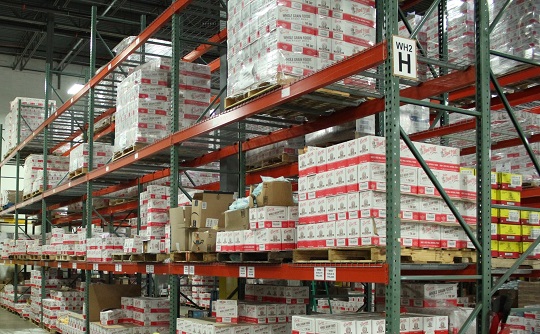In the world of supply chain management, one of the most important aspects is ensuring that raw materials are always available, in the right amount, at the right time. This is crucial to avoid production delays, stockouts, or overstocking, which can lead to increased costs, lost sales, and decreased customer satisfaction.
To achieve this goal, there are two main approaches: Material Requirements Planning (MRP) and replenishment using reorder point.
Each method has its own advantages and disadvantages, and it is important to choose the most suitable one for each material.
In this blog post, we will explore these two methods and discuss the factors to consider when deciding which method to use.
Before we delve into this interesting topic, make sure that you have also joined the scmguide telegram channel to receive notifications on the latest posts from this blog and gain more insights on other aspects of supply chain management.
Table of Contents
Material Requirements Planning (MRP)
MRP is a software-based approach to inventory management that uses data such as sales forecasts, production schedules, and lead times to determine the required quantity and timing of raw materials.
The system calculates the net requirements for each material, taking into account the current inventory levels, outstanding orders, and any existing reservations.
One of the advantages of MRP is its ability to provide a detailed and accurate plan for the entire supply chain, from raw materials to finished goods.
This allows companies to optimize their production schedules and avoid stockouts or overstocking.

MRP also enables companies to track their inventory levels in real-time, which can help them identify and resolve any issues or bottlenecks in the supply chain.
However, there are also some disadvantages to MRP.
One of the main drawbacks is its reliance on accurate data and forecasts.
If the input data is incorrect or outdated, the MRP system may generate inaccurate or irrelevant recommendations.
Additionally, MRP systems can be complex and costly to implement, which may be a barrier for smaller or less tech-savvy companies.
Replenishment using Reorder Point
Replenishment using reorder point is a simpler and more intuitive approach to inventory management.
The basic idea is to set a minimum inventory level, known as the reorder point, and reorder the material when the actual inventory level falls below this threshold.
The reorder point is calculated based on factors such as lead time, demand variability, and desired service level.
One of the advantages of replenishment using reorder point is its simplicity and ease of use. It requires less data and forecasting than MRP and can be implemented with minimal software or hardware requirements.
Additionally, it can be easily understood and managed by frontline employees, which can reduce the risk of errors or miscommunication.
However, there are also some disadvantages to replenishment using reorder point.
One of the main drawbacks is its lack of flexibility and responsiveness. Since the reorder point is fixed, it may not be able to adapt to sudden changes in demand or lead time. This can lead to stockouts or overstocking, which can be costly and disruptive.
You might also like:
- Improving the Efficiency of Non-Standard Warehouses: Renovation or Better Utilization?
- The Importance of Business Process Mapping and How to Do It Effectively
- Can Excess Inventory Benefit Your Business?
Choosing the right method
So, how do you decide which method to use for each material?
The answer depends on several factors, including the characteristics of the material, the demand pattern, the lead time, and the desired service level.
For example, MRP may be more suitable for materials with high demand variability, long lead times, or complex production processes, where accurate planning and coordination are essential.

On the other hand, replenishment using reorder point may be more suitable for materials with stable demand, short lead times, or low value, where simplicity and cost-effectiveness are more important.
It is also important to consider the trade-off between inventory holding costs and stockout costs.
MRP may result in higher inventory holding costs due to its tendency to generate higher safety stock levels, but it may also reduce the risk of stockouts and associated costs.
Replenishment using reorder point may result in lower inventory holding costs, but it may also increase the risk of stockouts and associated costs.
Another important factor to consider is the availability and quality of data.
MRP requires accurate and up-to-date data on sales forecasts, production schedules, lead times, and inventory levels, which may not be available or reliable in all cases.
Replenishment using reorder point, on the other hand, relies on simpler and more readily available data, such as current inventory levels and lead times.
In some cases, a combination of both methods may be used, depending on the characteristics of the material and the specific requirements of the supply chain. For example, MRP may be used for high-value or critical materials, while replenishment using reorder point may be used for low-value or non-critical materials.
When deciding which method to use, it is also important to consider the scalability and flexibility of the system.
As the business grows or changes, the inventory management system should be able to adapt and evolve accordingly. This may require upgrading or replacing the software, or changing the parameters and settings of the system.
In general, the key to successful inventory management is to strike a balance between inventory holding costs and stockout costs, while maintaining a high level of service to customers.
This requires a thorough understanding of the characteristics of each material, the demand pattern, the lead time, and the desired service level, as well as the availability and quality of data.
Conclusion
In conclusion, ensuring the availability of raw materials is a critical aspect of supply chain management. There are two main approaches to inventory management: Material Requirements Planning (MRP) and replenishment using reorder point.
Each method has its own advantages and disadvantages, and the choice depends on several factors, such as the characteristics of the material, the demand pattern, the lead time, and the desired service level.
To make an informed decision, it is important to have accurate and up-to-date data, as well as a thorough understanding of the supply chain dynamics and the trade-offs between inventory holding costs and stockout costs.
Additionally, the inventory management system should be scalable and flexible, to accommodate changes in the business environment.
By choosing the right method for each material, companies can optimize their inventory levels, reduce costs, and improve customer satisfaction.
Hope this is useful!
Please share this article with your colleagues so that they can also benefit from it. Join the scmguide telegram channel to stay notified of the latest articles from this blog and for more insights on supply chain management. All articles on this blog are free for you to use for any purpose, including commercial use, without attribution.

 by
by 

